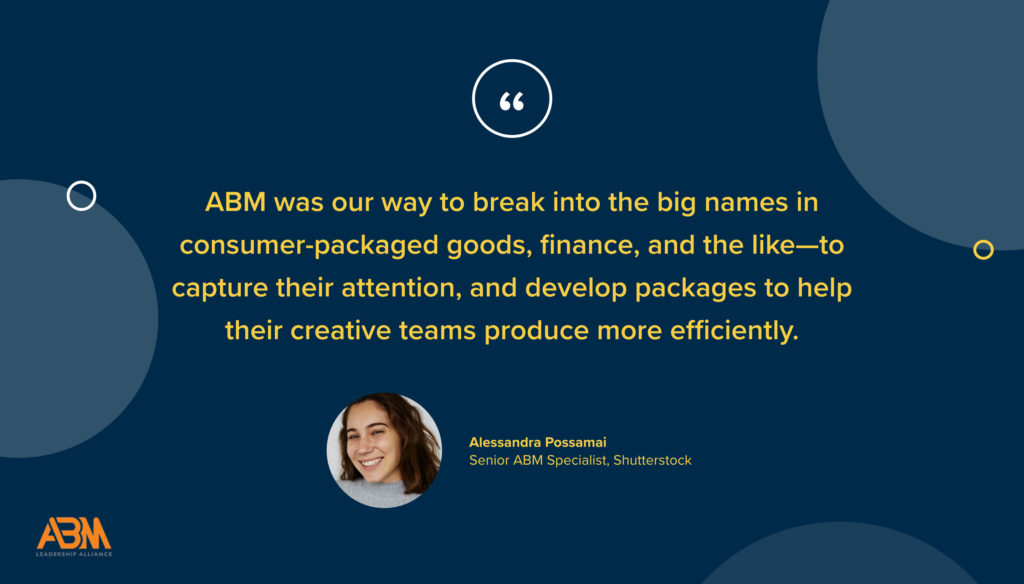ABM Now Issue #4
Expanding Output on a Reduced Budget
Shutterstock and Demandbase on downsizing ABM without sacrificing outcomes, and the partner marketing lift

This article is part of the ABM Now series where we explore how ABM has changed in 2020. What will you take with you? What will you leave behind? Read the whole series here.
“The more a thing tends to be permanent,” observed the philosopher Alan Watts, “the more it tends to be lifeless.” How true of people—and how true of businesses.
Today we’re all watching brands pick one of two camps: Those pretending nothing has changed and those that accept the change and adapt. We might call the former ones “team ostrich,” with their heads firmly planted in the sand. These are the companies still running ads with images of people without face masks and, in meetings, muttering some version of, “2020—when will it end?” The latter is team sparrow—after the world’s most adaptable bird. They understand that adaptation is the new normal, and I’m thrilled to be surrounded by colleagues and companies who are working with what they have, where they are.
Last week, I sat down with Alessandra Possamai, Senior ABM Specialist at Shutterstock, and Christine Farrier, Senior Director of Partner Marketing here at Demandbase, to ask, how are you adapting? Below are their top takeaways.
Takeaway #1: ABM is excellent for tackling new markets—and partners can play a star role
Alessandra Possamai
January 2020 now feels like a decade ago. Back then, we were thinking, “Now is when we finally turn our ABM program into a predictable engine.” Of course with Covid-19, a lot of what we had planned went out the door, but that foundation and the presence ABM helped us establish in B2B markets, has helped.
You’re probably familiar with Shutterstock as the global leader in stock content ecommerce and a creative platform for images, videos, music, and editorial assets. Our B2B marketing function really only began growing in 2017. For us, ABM was our way to break into the big names in consumer-packaged goods, finance, and the like—to capture their attention, and develop packages to help their creative teams produce more efficiently.
In 2018, we were launching as many campaigns as we could against a list of 30 Tier 1 accounts. In 2019, we grew that list to 1,000 accounts and accumulated the technology to go even bigger. Come 2020, we had more budget and more tools, and I’d say ABM helped us refine those offerings and build a presence in those markets that have sustained us, even as we’ve had to scale it back.

Christine
Similar to Alessandra, this year, we were ready to stress test our metrics. We had proven our value and had good benchmarks, and we wanted to see if we could increase them all by 20 percent. For me, the way to do that is partner marketing (of course).
In tough times, partners can help you more easily expand. You can make a Venn diagram and see where your lists overlap, coordinate, and run joint plays. It makes the universe of messages and campaigns you have to send a bit smaller and more manageable.
Partners can also multiply the effectiveness of promotion for events like webinars. If it’s just you telling a prospect to join, they might. But if they’re suddenly hearing it from two or three peers, it’s a lot more persuasive. It increases the messaging density. They’re like, “Oh, okay, I now have three friends telling me. Let me go check this out.”
Including partners for a co-marketing lift has become a requirement for us. If we can’t find an internal expert and a strong partner to bring to a webinar, maybe we don’t do it at all, or wait until we can hit that benchmark. Prospects want your A-game right now, and partners can really help you deliver.
Takeaway #2: When cost-cutting, start with non-justifiable spend
Alessandra
It was an interesting challenge scaling up an ABM program, and an equally challenging endeavor switching gears and adapting to the realities of the market. It was a lot at once. We had to look very hard at what we’re doing and ask, “Where can we still have the most impact? What are things we might have to scale back?” Invariably, that led us back to the campaigns and activities that had made our ABM program successful in the first place. We ended up spending on fewer accounts, but spending more on each of them, and in the end, we’re seeing great results.
Now of course, figuring out what to scale back on is tricky. ABM isn’t some inbound channel where everything is direct attribution. You’re often looking more at metrics and engagement. It presented an opportunity to educate internal stakeholders on the impact of certain marketing channels beyond the traditional form fill. My response was, “Let me tell you how this is different, and here’s an anecdotal example of how it worked.” For instance, after seeing a one-to-one personalized LinkedIn ad, we got a response to an SDR’s outreach from the CMO at a top CPG company who told the SDR the only reason why he was replying to their email was because of the targeted ad. Then he referred the SDR to people to get in touch with.
Throughout it all, having Demandbase was a really useful tool to show what we were spending and the impact across the funnel, and that’s not just because Christine is on the call. It illuminates bookings within target accounts and helped us justify spend on that channel.
Christine
We’re similar to Alessandra and it’s interesting to see the parallels. We had to make some hard choices around narrowing our focus. At first, I felt the industry was floundering and everyone was just trying to regain their footing. We shifted much of our focus to customer retention and renewals, and had to ask, “Are the partners who helped us drive net-new also the ones who can help us drive retention and expansion?”
At the same time, we’re reviewing all our programs to ensure we’re getting the basics right. The basics aren’t hard, and yet all the time, I see companies get it wrong. Our competitors still send me GrubHub gift cards and I’m like, “Literally, we’re on the same Forrester Wave report. Of course, I show high intent. We compete.” Word to the wise, scrub your list for competitors.
Takeaway #3: Keep up ABM until sales demands it
Alessandra:
You’ll know ABM is working because when the market gets tough, sales comes asking for help. I’ve now had people from different departments who I’ve never spoken to reach out and say, “Can you help me with this account?” ABM successes create a buzz and the momentum builds from there. There was one account, in particular, that was a challenge to gain traction with. We instituted a weekly meeting with the sales team to ask, “Ok. What happened last week? What can we shift, pivot, or update?” And sure enough, we landed the account. The perception of ABM’s success and its ability to solve problems inspired the SDRs to stick with us through it all.
Given everything you’ve learned this year, what will you leave behind?
Alessandra
Gosh, it’s been an unpredictable year. Across different industries, marketing budgets have been scaled back requiring more justification. I think thrift is good but some things don’t show immediate success, especially in long B2B cycles. I would leave behind the current ‘budget lockdown’ so we can return to more experimentation.
Christine
I’d say, I would leave behind vendors that have a totally hands-off approach. Does this sound familiar? “Here’s our product, take it or leave it.” The companies I’ve most appreciated in this time are those willing to work with us, to innovate, and to help us get more out of their product. The value of customer service is at an all-time high and I’d like to leave behind the vendors that don’t get that.
What will you take with you?
Alessandra
Our new, stronger sales relationship. I want to weave sales even more into the marketing process. In the beginning of 2020, our view of ABM was very marketing-centric. This time has shown us how important it is to communicate with certain members of the sales team to drive things forward, get their thoughts on a campaign, and create a feedback loop. This year has shown me that there’s always room to deepen that relationship.
Christine
Building a presence on social. I’ve seen people get incredibly creative on LinkedIn, and I have a lot to learn. Right now if I owned a hashtag, it’d be #BoringButUseful. What I’d take forward is all that inspiration I’m getting from people’s social presence, and putting your ideas out there.

Christine Farrier
Sr. Director, Partner and Channel Marketing, Demandbase
Christine Farrier is the Senior Director of Partner Marketing at Demandbase. In this role, she brings together substantive marketing, communications and entrepreneurial expertise primarily focused in the investment banking and technology industries. Prior to joining Demandbase, Christine held marketing leadership roles with IHS Markit and Imagine Software and successfully exited from her arts and culture startup.

Alessandra Possamai
Senior ABM Specialist, Shutterstock
Alessandra currently manages Shutterstock’s global ABM program. She has over two years of experience building and scaling ABM impact across the organization. In this role, she plans and executes multi-dimensional programs to generate opportunities in collaboration with the sales development team within specific, targeted accounts.

Brandon Redlinger
Director of Demand Gen, Demandbase
Brandon possesses extensive experience helping organizations create and orchestrate strategic programs that help to retain customers and power sales execution. He’s passionate about the intersection between tech and psychology, especially as it applies to growing businesses. He enjoys reading, playing hockey, and most outdoor sports. Check him out on twitter @brandon_lee_09 or connect with him on LinkedIn at www.linkedin.com/in/brandonredlinger/.
